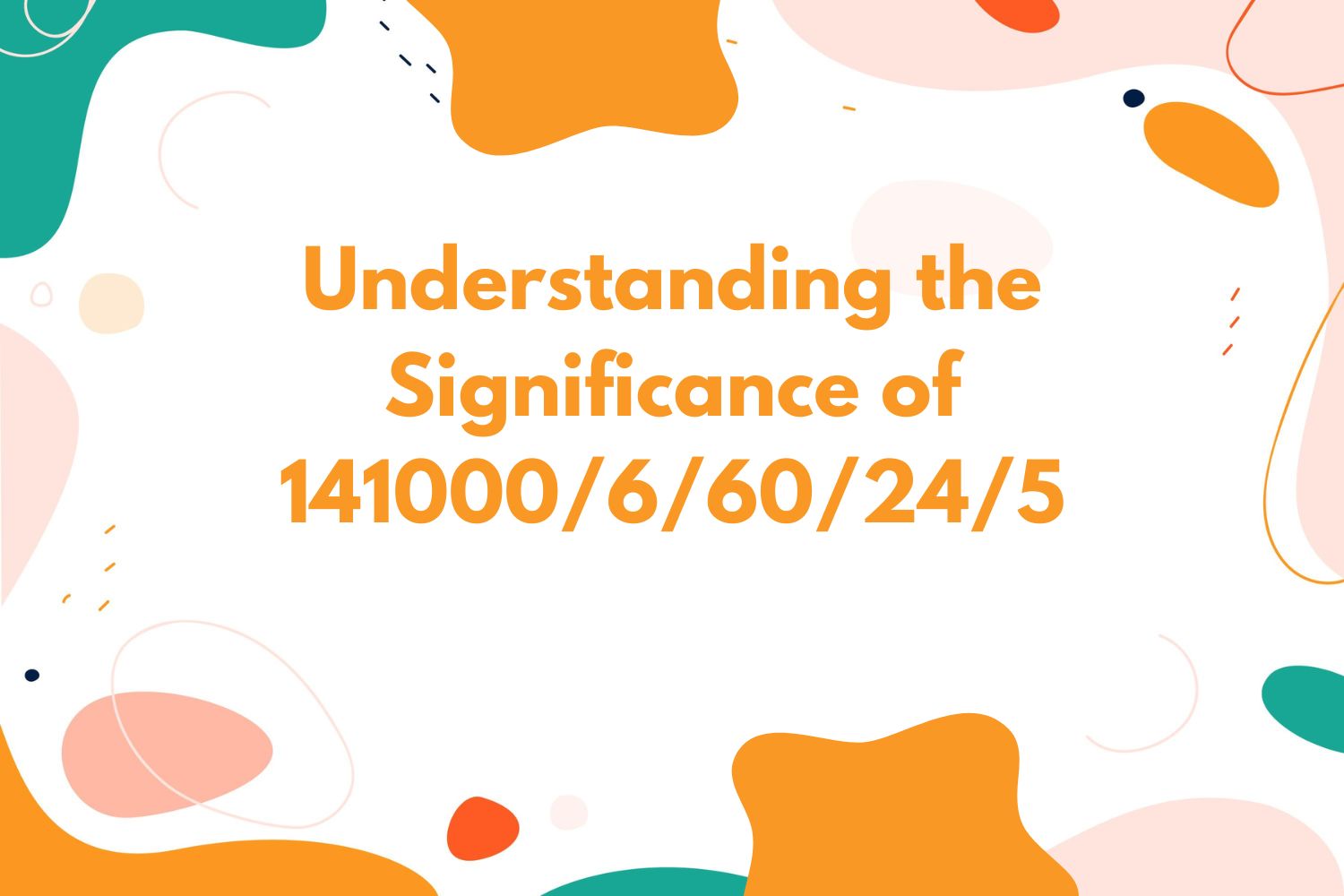
Understanding the Significance of 141000/6/60/24/5
When I first encountered the string “141000/6/60/24/5,” it struck me as a cryptic formula, a puzzle waiting to be unraveled. At first glance, it appears as a series of numbers divided by slashes, each potentially holding a different meaning. But what exactly does this sequence represent? Let’s dive into this fascinating code and uncover its possible meanings and applications.
Breaking Down the Sequence
To start, let’s break down the sequence “141000/6/60/24/5” into its constituent parts:
- 141000: This large number stands out. Could it represent a quantity, a statistic, or a value in some specific context?
- 6: A smaller number, which could imply division into parts, a time unit, or perhaps a measurement.
- 60: Commonly associated with minutes in an hour or seconds in a minute.
- 24: Often relates to hours in a day.
- 5: Could signify days in a working week, or another segmented unit of time or measure.
With these parts identified, let’s explore several potential interpretations and their relevance.
Potential Interpretations
1. Time Management in Project Planning
Imagine you are managing a project with a total of 141,000 minutes available. Breaking this down:
- 6: The project is divided into 6 major phases.
- 60: Each hour in the workday (assuming a traditional division of time).
- 24: Reflecting the 24 hours available in a day.
- 5: Denoting a 5-day work week.
In this context, the sequence helps in calculating the exact amount of time allocated per phase, ensuring efficient time management. For example:
141,000 minutes6 phases=23,500 minutes per phase\frac{141,000 \text{ minutes}}{6 \text{ phases}} = 23,500 \text{ minutes per phase}6 phases141,000 minutes=23,500 minutes per phase
Now, if we break it further into daily work hours:
23,500 minutes per phase60 minutes per hour=391.67 hours per phase\frac{23,500 \text{ minutes per phase}}{60 \text{ minutes per hour}} = 391.67 \text{ hours per phase}60 minutes per hour23,500 minutes per phase=391.67 hours per phase 391.67 hours per phase24 hours per day=16.32 days per phase\frac{391.67 \text{ hours per phase}}{24 \text{ hours per day}} = 16.32 \text{ days per phase}24 hours per day391.67 hours per phase=16.32 days per phase 16.32 days per phase5 workdays per week=3.26 weeks per phase\frac{16.32 \text{ days per phase}}{5 \text{ workdays per week}} = 3.26 \text{ weeks per phase}5 workdays per week16.32 days per phase=3.26 weeks per phase
This kind of breakdown allows project managers to allocate resources and timelines more effectively, ensuring that each phase is adequately planned.
2. Fitness and Health Regimen
The sequence can also be adapted to a fitness or health regimen. Suppose you have a target of burning 141,000 calories:
- 6: You plan to achieve this in 6 months.
- 60: You dedicate 60 minutes per workout session.
- 24: Representing 24 workout days in a month.
- 5: Corresponding to 5 workout days in a week.
Here’s how you can break it down:
141,000 calories6 months=23,500 calories per month\frac{141,000 \text{ calories}}{6 \text{ months}} = 23,500 \text{ calories per month}6 months141,000 calories=23,500 calories per month 23,500 calories per month24 workout days per month=979.17 calories per workout\frac{23,500 \text{ calories per month}}{24 \text{ workout days per month}} = 979.17 \text{ calories per workout}24 workout days per month23,500 calories per month=979.17 calories per workout 979.17 calories per workout60 minutes per workout≈16.32 calories per minute\frac{979.17 \text{ calories per workout}}{60 \text{ minutes per workout}} \approx 16.32 \text{ calories per minute}60 minutes per workout979.17 calories per workout≈16.32 calories per minute
By calculating the calories burned per minute, you can tailor your workouts to be effective, ensuring you meet your fitness goals within the planned timeframe.
3. Financial Planning
In a financial context, let’s say you have a budget of $141,000:
- 6: Budget divided into 6 months.
- 60: Allocated to 60 different expense categories or transactions.
- 24: Spread over 24 weeks.
- 5: Corresponding to 5 key financial goals.
Breaking this down, you can manage your finances as follows:
141,000 dollars6 months=23,500 dollars per month\frac{141,000 \text{ dollars}}{6 \text{ months}} = 23,500 \text{ dollars per month}6 months141,000 dollars=23,500 dollars per month 23,500 dollars per month24 weeks=979.17 dollars per week\frac{23,500 \text{ dollars per month}}{24 \text{ weeks}} = 979.17 \text{ dollars per week}24 weeks23,500 dollars per month=979.17 dollars per week 979.17 dollars per week5 financial goals=195.83 dollars per goal per week\frac{979.17 \text{ dollars per week}}{5 \text{ financial goals}} = 195.83 \text{ dollars per goal per week}5 financial goals979.17 dollars per week=195.83 dollars per goal per week
This helps in creating a structured financial plan, allowing for effective monitoring and adjustment of expenses to meet your goals.
Applying the Formula in Daily Life
The versatility of “141000/6/60/24/5” lies in its adaptability to various scenarios. Whether managing time, fitness, or finances, this sequence serves as a robust framework for planning and execution.
To apply this in daily life:
- Identify Your Total Resource/Goal: Be it time, calories, or money, start with your total amount.
- Divide into Manageable Units: Break this down into smaller, manageable parts.
- Allocate Resources Wisely: Ensure each part receives appropriate attention and resources.
- Monitor Progress: Regularly check progress to stay on track and make necessary adjustments.
Conclusion
“141000/6/60/24/5” is more than just a string of numbers. It’s a tool for efficiency, a method to streamline various aspects of life. By breaking down large tasks into smaller, manageable parts, you can achieve your goals systematically and effectively. So, next time you face a daunting task, remember the power of this sequence and how it can help you organize and conquer your challenges.
Also Read:
Harsh Mistri is a Digital Marketing Consultant and professional Blogger. He has 6+ years of experience in SEO, SMO, ASO, Blogging, ORM & Google Ads. He loves to learn new things Very Much.





